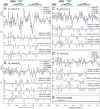No evidence from FTIR difference spectroscopy that glutamate-189 of the D1 polypeptide ligates a Mn ion that undergoes oxidation during the S0 to S1, S1 to S2, or S2 to S3 transitions in photosystem II
- PMID: 16846223
- PMCID: PMC2515374
- DOI: 10.1021/bi060583a
No evidence from FTIR difference spectroscopy that glutamate-189 of the D1 polypeptide ligates a Mn ion that undergoes oxidation during the S0 to S1, S1 to S2, or S2 to S3 transitions in photosystem II
Abstract
In the recent X-ray crystallographic structural models of photosystem II, Glu189 of the D1 polypeptide is assigned as a ligand of the oxygen-evolving Mn(4) cluster. To determine if D1-Glu189 ligates a Mn ion that undergoes oxidation during one or more of the S(0) --> S(1), S(1) --> S(2), and S(2) --> S(3) transitions, the FTIR difference spectra of the individual S-state transitions in D1-E189Q and D1-E189R mutant PSII particles from the cyanobacterium Synechocystis sp. PCC 6803 were compared with those in wild-type PSII particles. Remarkably, the data show that neither mutation significantly alters the mid-frequency regions (1800-1200 cm(-)(1)) of any of the FTIR difference spectra. Importantly, neither mutation eliminates any specific symmetric or asymmetric carboxylate stretching mode that might have been assigned to D1-Glu189. The small spectral alterations that are observed are similar in amplitude to those that are observed in wild-type PSII particles that have been exchanged into FTIR analysis buffer by different methods or those that are observed in D2-H189Q mutant PSII particles (the residue D2-His189 is located >25 A from the Mn(4) cluster and accepts a hydrogen bond from Tyr Y(D)). The absence of significant mutation-induced spectral alterations in the D1-Glu189 mutants shows that the oxidation of the Mn(4) cluster does not alter the frequencies of the carboxylate stretching modes of D1-Glu189 during the S(0) --> S(1), S(1) --> S(2), or S(2) --> S(3) transitions. One explanation of these data is that D1-Glu189 ligates a Mn ion that does not increase its charge or oxidation state during any of these S-state transitions. However, because the same conclusion was reached previously for D1-Asp170, and because the recent X-ray crystallographic structural models assign D1-Asp170 and D1-Glu189 as ligating different Mn ions, this explanation requires that (1) the extra positive charge that develops on the Mn(4) cluster during the S(1) --> S(2) transition be localized on the Mn ion that is ligated by the alpha-COO(-) group of D1-Ala344 and (2) any increase in positive charge that develops on the Mn(4) cluster during the S(0) --> S(1) and S(2) --> S(3) transitions be localized on the one Mn ion that is not ligated by D1-Asp170, D1-Glu189, or D1-Ala344. An alternative explanation of the FTIR data is that D1-Glu189 does not ligate the Mn(4) cluster. This conclusion would be consistent with earlier spectroscopic analyses of D1-Glu189 mutants, but would require that the proximity of D1-Glu189 to manganese in the X-ray crystallographic structural models be an artifact of the radiation-induced reduction of the Mn(4) cluster that occurred during the collection of the X-ray diffraction data.
Figures


Similar articles
-
No evidence from FTIR difference spectroscopy that aspartate-342 of the D1 polypeptide ligates a Mn ion that undergoes oxidation during the S0 to S1, S1 to S2, or S2 to S3 transitions in photosystem II.Biochemistry. 2007 Mar 20;46(11):3151-60. doi: 10.1021/bi062195e. Epub 2007 Feb 24. Biochemistry. 2007. PMID: 17319696 Free PMC article.
-
No evidence from FTIR difference spectroscopy that aspartate-170 of the D1 polypeptide ligates a manganese ion that undergoes oxidation during the S0 to S1, S1 to S2, or S2 to S3 transitions in photosystem II.Biochemistry. 2005 Feb 8;44(5):1367-74. doi: 10.1021/bi047558u. Biochemistry. 2005. PMID: 15683222
-
Evidence that the C-terminus of the D1 polypeptide of photosystem II is ligated to the manganese ion that undergoes oxidation during the S1 to S2 transition: an isotope-edited FTIR study.Biochemistry. 2004 Mar 23;43(11):3152-66. doi: 10.1021/bi035915f. Biochemistry. 2004. PMID: 15023066
-
FTIR detection of water reactions in the oxygen-evolving centre of photosystem II.Philos Trans R Soc Lond B Biol Sci. 2008 Mar 27;363(1494):1189-94; discussion 1194-5. doi: 10.1098/rstb.2007.2214. Philos Trans R Soc Lond B Biol Sci. 2008. PMID: 17965007 Free PMC article. Review.
-
The O2-Evolving Complex of Photosystem II: Recent Insights from Quantum Mechanics/Molecular Mechanics (QM/MM), Extended X-ray Absorption Fine Structure (EXAFS), and Femtosecond X-ray Crystallography Data.Acc Chem Res. 2017 Jan 17;50(1):41-48. doi: 10.1021/acs.accounts.6b00405. Epub 2016 Dec 21. Acc Chem Res. 2017. PMID: 28001034 Review.
Cited by
-
Where water is oxidized to dioxygen: structure of the photosynthetic Mn4Ca cluster from X-ray spectroscopy.Inorg Chem. 2008 Mar 17;47(6):1711-26. doi: 10.1021/ic7016837. Inorg Chem. 2008. PMID: 18330965 Free PMC article.
-
Proton-coupled electron transfer.Chem Rev. 2007 Nov;107(11):5004-64. doi: 10.1021/cr0500030. Chem Rev. 2007. PMID: 17999556 Free PMC article. Review. No abstract available.
-
Fourier transform infrared difference spectroscopy for studying the molecular mechanism of photosynthetic water oxidation.Front Plant Sci. 2013 May 21;4:146. doi: 10.3389/fpls.2013.00146. eCollection 2013. Front Plant Sci. 2013. PMID: 23734156 Free PMC article.
-
The PSII calcium site revisited.Photosynth Res. 2007 Jun;92(3):275-87. doi: 10.1007/s11120-006-9124-2. Epub 2007 Jan 19. Photosynth Res. 2007. PMID: 17235491 Review.
-
Computational studies of the O(2)-evolving complex of photosystem II and biomimetic oxomanganese complexes.Coord Chem Rev. 2008 Feb;252(3-4):395-415. doi: 10.1016/j.ccr.2007.09.006. Coord Chem Rev. 2008. PMID: 19190716 Free PMC article.
References
-
- Vrettos JS, Brudvig GW. Oxygen Evolution. Compr. Coord. Chem. II. 2004;8:507–547.
-
- Hillier W, Messinger J. Mechanism of Photosynthetic Oxygen Production. In: Wydrzynski T, Satoh Ki., editors. Photosystem II: The Light-Driven Water:Plastoquinone Oxidoreductase. Springer, Dordrecht; The Netherlands: 2005. pp. 567–608.
Publication types
MeSH terms
Substances
Grants and funding
LinkOut - more resources
Full Text Sources

